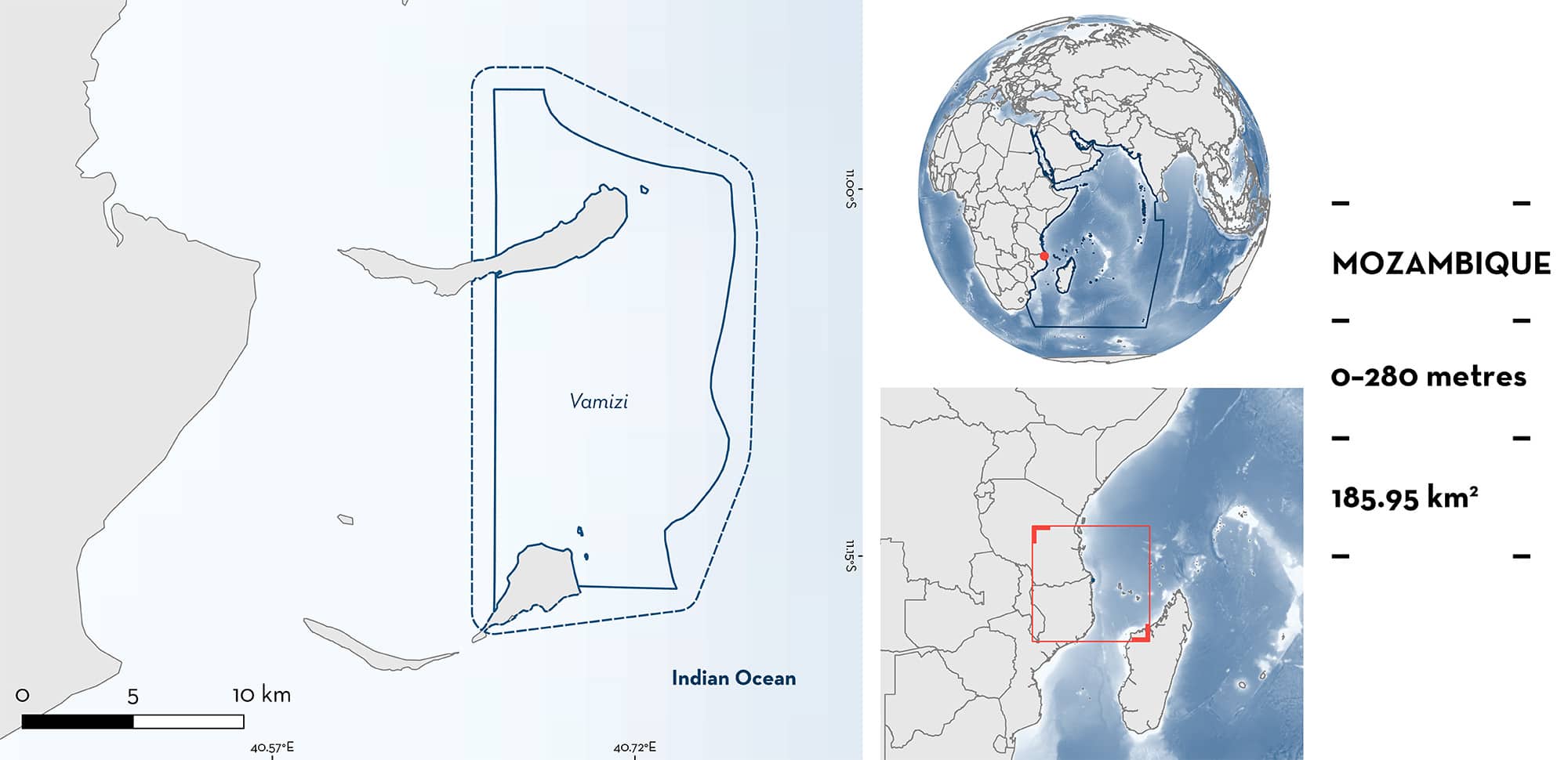ISRA FACTSHEETS
ISRA FACTSHEETS
WESTERN INDIAN OCEAN REGION
Vamizi
Summary
Vamizi lies in the northern Quirimbas Archipelago of northern Mozambique. It is a coral reef habitat between the two islands of Vamizi and Metundo. The area is characterised by steep reef walls, shallow reef tops, and pelagic waters. The area partly overlaps with the Vamizi Key Biodiversity Area and lies within three Ecologically or Biologically Significant Marine Areas (Mozambique Channel, Northern Mozambique Channel, and Pemba Bay to Mtwara). Within the area there are: threatened species (e.g., Blacktip Reef Shark Carcharhinus melanopterus); reproductive areas (Grey Reef Shark Carcharhinus amblyrhynchos); and undefined aggregations (Blacktip Reef Shark).
Download factsheet
Vamizi
DESCRIPTION OF HABITAT
Vamizi lies in the Quirimbas Archipelago in northern Mozambique. It is located in the waters around Vamizi and Metundo Islands, which are ~5–20 km off the mainland. The area is characterised by pelagic waters, coral reef habitats including shallow reef tops and steep walls, and deep canyons to ~500 m between the reefs (Davidson et al. 2006). Vamizi is influenced by the northeast monsoon from October to March, which brings warm temperatures and seasonal rains, and by the southeast monsoon from April to September, which is associated with the cooler dry season and strong southerly winds (Davidson et al. 2006). The large tidal range (>4 m spring equinox tides), combined with strong periodic upwelling events, draw cool nutrient rich waters up from the adjacent deepwater canyons, conferring strong currents, a resilience to coral bleaching events (West & Salm 2003), and a regular nutrient input known to support one of the highest productivities in Western Indian Ocean coral reef systems (Benkwitt et al. 2021). The coral reefs in this area are some of the most diverse in the Western Indian Ocean (Obura 2012).
The area partly overlaps with the Vamizi Key Biodiversity Area (KBA 2023) and lies within three Ecologically or Biologically Significant Marine Areas (Mozambique Channel, Northern Mozambique Channel, and Pemba Bay to Mtwara; CBD 2023a, 2023b, 2023c). The area also partly overlaps with a community sanctuary around Vamizi Island.
This Important Shark and Ray Area is benthopelagic from surface waters (0 m) to 280 m based on the global depth range of the Qualifying Species.
CRITERION A
VULNERABILITY
The two Qualifying Species within the area are considered threatened with extinction according to the IUCN Red List of Threatened SpeciesTM. These are the Endangered Grey Reef Shark (Simpfendorfer et al. 2020a) and the Vulnerable Blacktip Reef Shark (Simpfendorfer et al. 2020b).
CRITERION C
SUB-CRITERION C1 – REPRODUCTIVE AREAS
Vamizi is an important reproductive area for one shark species.
Divers frequently observe pregnant female and neonate (~70 cm total length [TL]) Grey Reef Sharks at Baixa de Methundo canyon, locally known as Neptune’s Reef (I Marques da Silva pers. obs. 2023). Pregnancy was visually assessed underwater by a visibly extended abdomen. Aggregations during the peak season from August–September comprised an average of ~30 individuals (T Hempson pers. obs. 2010–2013). Two pregnant females with visibly distended abdomens were tagged in 2014 and only females have been reported in the aggregations seen by divers at Neptune’s Reef. At the end of September, neonates and young-of-the-year (YOY) are regularly reported in the same area, indicating that pupping may have occurred in the area (I Marques da Silva pers. obs. 2023). For example, 10 neonates or YOY were regularly observed at this site for several weeks in August–September 2012, and a further 12 neonates or YOY were regularly seen over a period of ~6 weeks in September–October 2013 (T Hempson unpubl. data 2023). Sizes were estimated to be 60–90 cm TL, classifying them as neonates or YOY considering their reported size-at-birth of 60 cm TL (Wetherbee et al. 1997).
CRITERION C
SUB-CRITERION C5 – UNDEFINED AGGREGATIONS
Vamizi is an important area for undefined aggregations of one shark species.
Local ecological knowledge (LEK) suggests there are regular aggregations of Blacktip Reef Sharks in this area, mostly based on unrecorded observations by people walking along the beach while on turtle patrol (I Marques da Silva pers. obs. 2023). Blacktip Reef Sharks aggregate in shallow water, often with the tip of the dorsal fin out of the water. The species has been recorded since 2012 when it was seen on a Baited Remote Underwater Video (BRUV) in 2 m depth, but numbers have increased since. In 2022–2023, turtle patrol officers reported seeing the species almost every day. To complement the LEK, a dedicated effort was made in August and September 2023 to quantify Blacktip Reef Shark aggregations in Vamizi. Six aggregations (min = 3, mean = 5, max = 8 individuals) were reported during nine surveys, with the species also seen on the remaining three surveys (1, 1, and 2 individuals). While mostly small Blacktip Reef Sharks with a visual size estimate of < 70 cm TL are seen, some large individuals (> 100 cm TL) were also reported.
Download factsheet
SUBMIT A REQUEST
ISRA SPATIAL LAYER REQUEST
To make a request to download the ISRA Layer in either a GIS compatible Shapefile (.shp) or Google Earth compatible Keyhole Markup Language Zipped file (.kmz) please complete the following form. We will review your request and send the download details to you. We will endeavor to send you the requested files as soon as we can. However, please note that this is not an automated process, and before requests are responded to, they undergo internal review and authorization. As such, requests normally take 5–10 working days to process.
Should you have questions about the data or process, please do not hesitate to contact us.


